The Galactic Center -- Nucleus of the Milky Way
Key points: How the Galactic Center was hidden; evidence for a black hole AND for recent star formation; the circumnuclear ring
Centers of galaxies harbor ultramassive black holes that we see as quasars or bright radio galaxies, exotic objects that make huge amounts of energy. Does the Milky Way have such a black hole? What can we learn about quasars given the detail we can observe so close up (just 8,000 parsecs)?
Conditions for star formation and evolution must be very different in this region. If we lived in the center of a galaxy, there would be a million stars between us and another star at 1 parsec distance such as alpha Centaurus. In our actual position, alpha Centaurus is the closest star. This huge density of stars may cause peculiar things to happen them as they form and evolve.
In the nearest galaxies, the highest resolution pictures we have taken show details only down to 10 to 30 light years. With perhaps 100,000,000 stars lumped together, we can barely see even the brightest individual stars. Also, we cannot study what happens really close to any possible black hole.
The center of the Milky Way is 100 times closer than the next closest galactic nucleus, so we can take pictures showing details 0.03 light years in size. This "cosmic zoom lens" makes the Galactic Center have an importance for galaxy studies similar to the importance of the sun for stellar work.
Extinction makes the Galactic Center inaccessible to visible-light astronomy. It was located approximately by radio measurements, then definitively in the starlight at 2Ám.
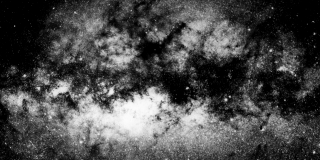 |
The central few hundred parsecs in visible light: the view is dominated by thick obscuring clouds in the disk of the Milky Way. |
 |
The central few hundred parsecs in near-infrared light: what a difference! We see through most of the dust to get an impression of what the galaxy is really like. (2MASS Project, http://www.ipac.caltech.edu/2mass/gallery/showcase/allsky_stars/fullres.html) |
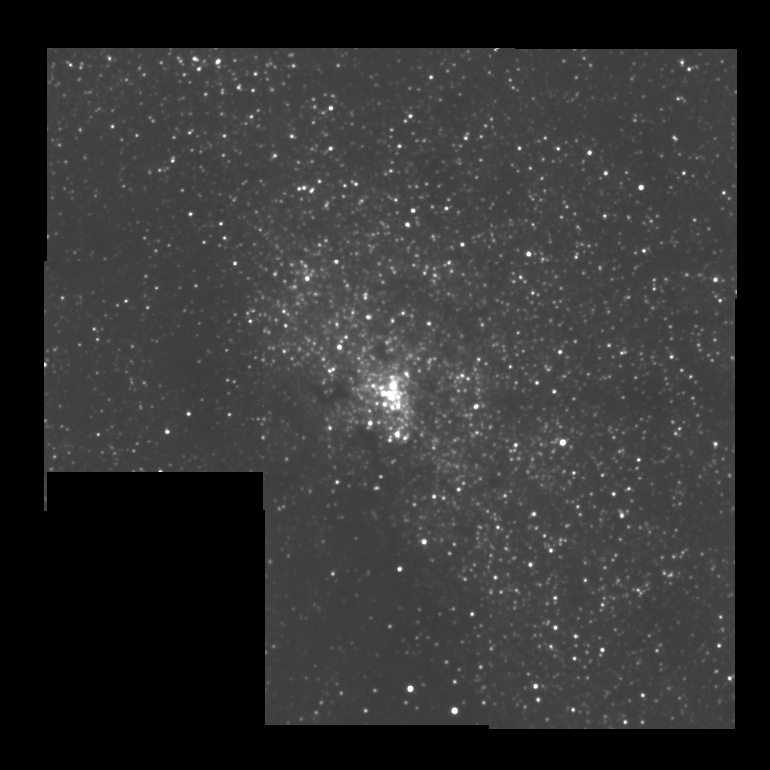 |
An infrared image about 10 parsecs across shows lots of very luminous stars and leaves little doubt where the true center lies (From M. & G. Rieke). |
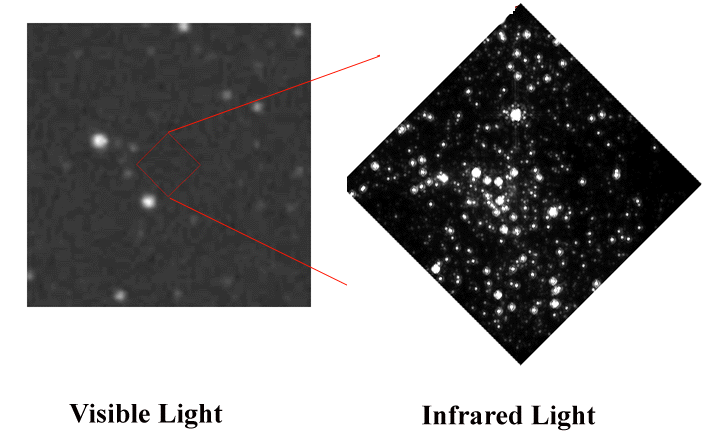 |
Even knowing exactly where to look does not help in the visible -- there are just a few foreground stars that lie in front of the heavy clouds of obscuring dust that hide the real center. |
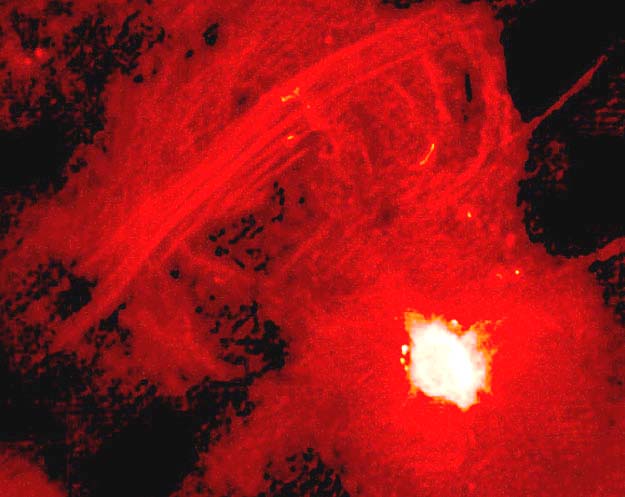 |
The region is a dramatic radio source. Here is the central roughly hundred parsecs in the radio. The Galactic Center itself is the bright source to the lower right. The arcs are thought to be hot gas flowing along a strong magnetic field.(From F. Yussef-Zadeh, VLA, APOD, http://antwrp.gsfc.nasa.gov/apod/ap020521.html) |
When first oberved in the infrared, the Galactic Center was shown to have strongly heated dust. Since the dust is likely to be heated by ultraviolet light, there must be an energetic source of UV there. The search for the source was on! Everyone hoped it would be a black hole!
Where is the Energy Source?
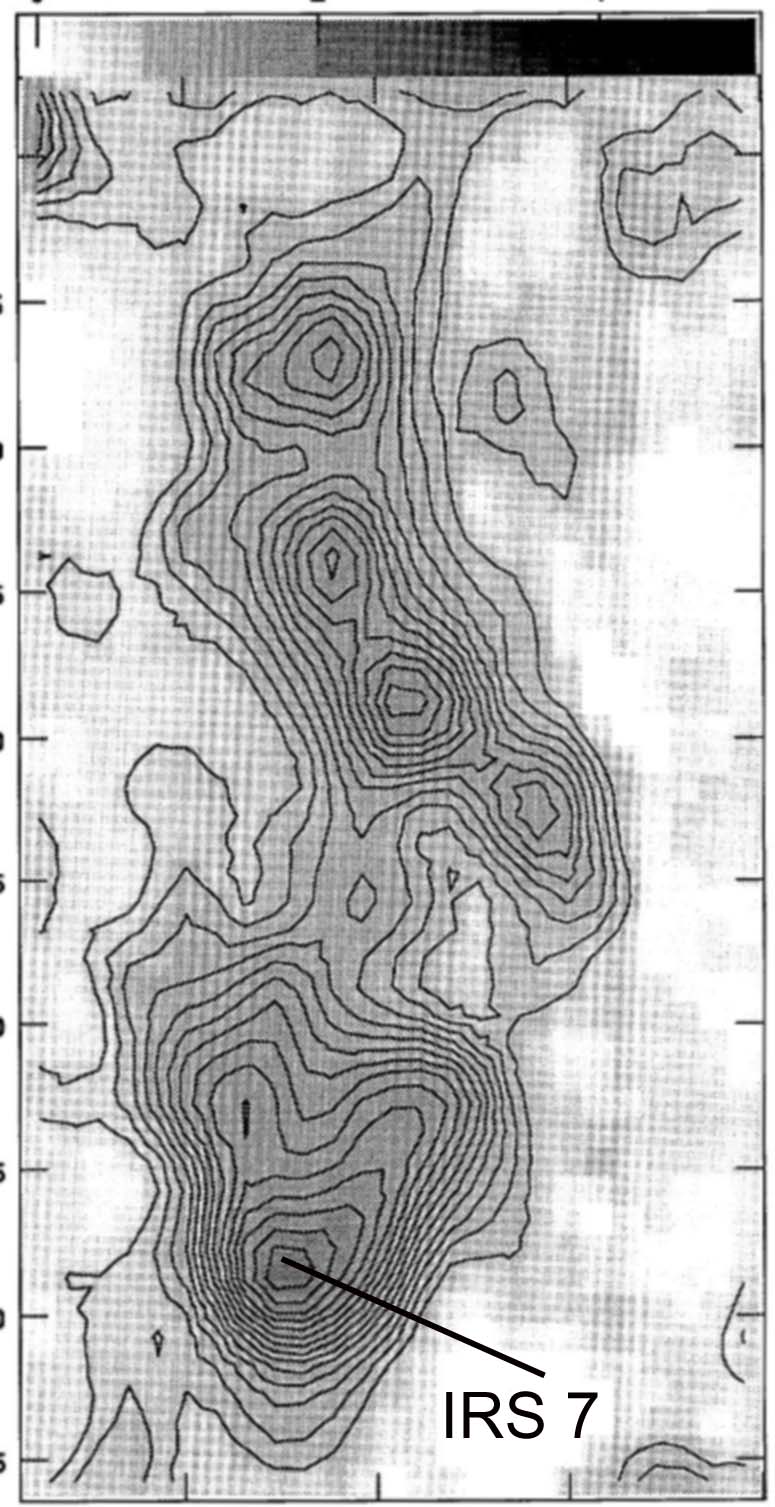 |
Spectra show many of the brightest sources are
normal red supergiants. There is a tail of excited gas being blown out of the
brightest cool star (IRS 7) (from Yusef-Zadeh and Melia). This indicates it lies near the unique cluster of hot blue stars and
therefore lies in the Galactic Center. As a result, we conclude we are seeing the normal
stages of evolution of massive stars. Stars must have formed in the Galactic Center in the
last 10 million years, since that is how long it would take to evolve to the red
supergiant. The members of the cluster of blue stars are also very massive -- more than 30 solar masses -- and hence very young. They are close to the supernova stage. They contribute to the energy but are not hot enough to provide it all -- the main sequence blue stars (at or below our current detection limit) are hotter and make more energy despite their faintness in the near infrared. |
Could there still be a black hole?????
Even if it doesn't make much energy, there might be a black hole. After 20 years of controversy, we finally managed to measure enough velocities of stars to measure the gravitational field accurately. We can now say: "Certainly! There is a 3 million solar mass black hole."
 |
The huge mass seems to be associated with this
strange radio source. Here is a plot of the mass enclosed in spheres centered on it
-- there is a mass of 2.6 million M |
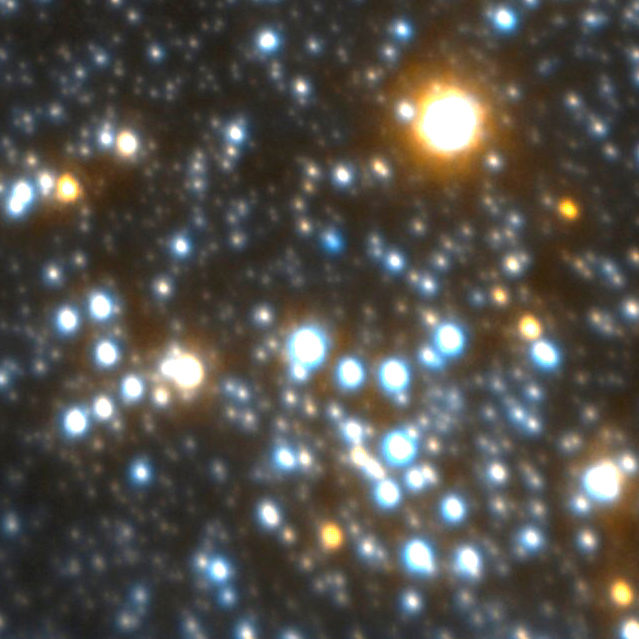 |
Ever increasing resolution showed the black hole is not the energy source. The brightest source in the very high resolution near infrared image to the right is IRS 7, a red supergiant that puts out most of its energy in the near infrared. The other bright stars are also very young and massive. The blue-appearing ones in the center of the image are a unique clustering of very luminous, massive stars. (image from Gemini Project) |
If the black hole dominated the energy of the Galactic Center, it would be the second brightest source in the infrared image. Instead, it is invisible, as shown in the animation below!
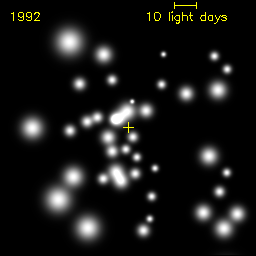 |
This series of images shows the stars moving very rapidly (~1000 km/sec) in their orbits around the position of Sgr A* (the small yellow cross). On this scale, its motion would be imperceptibly small, so this animation demonstrates that it is truly undetected - there is no source to be seen under the yellow cross. The data were obtained over about a decade. (The image covers only about 1/4 of the image above) from MPE infrared group, http://www.mpe.mpg.de/www_ir/GC/gc.html
|
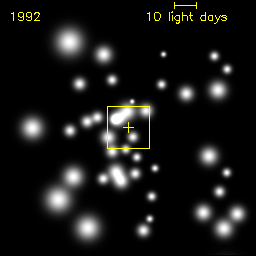 |
If we zoom in on Sgr A*, we see better the very high speeds of the stars that come very close. There is no trace of the central black hole, though, other than the effect of its mass on the stellar orbits. |
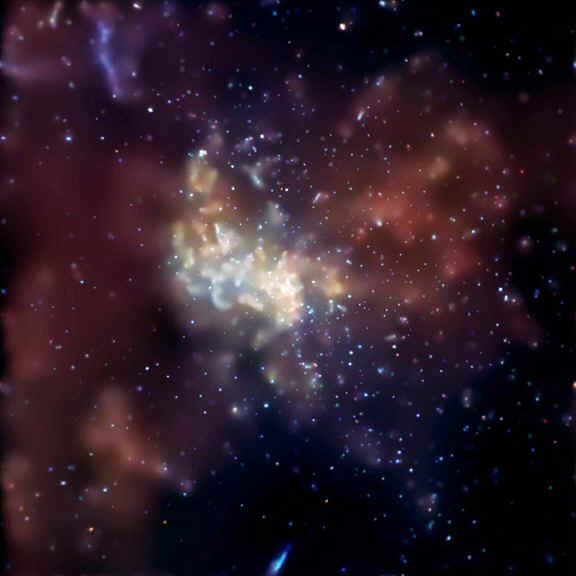 |
Here is a very deep, high resolution (1 arcsec) xray image of the
Galactic Center -- the source elongated up and down just above and to the right of the
center is Sgr A*, but it doesn't stand out at all. Even in X-rays,
where we look to find stellar black holes, there is nothing to draw our attention to the
supermassive black hole here!(from NASA/CXC/MIT/F.K.Baganoff
et al. http://chandra.harvard.edu/photo/2003/0203long/index.html)
|
It has become apparent that there is no significant source in the near infrared associated with the black hole (although brief flares have been detected). The lack of energy from the Galactic Center black hole has turned out to be a major challenge to our theories of black holes.
However, we can see the black hole in the radio!
A super-compact radio source was also discovered -- Sagittarius A*, Sgr A* for short.
What is happening with the interstellar gas?
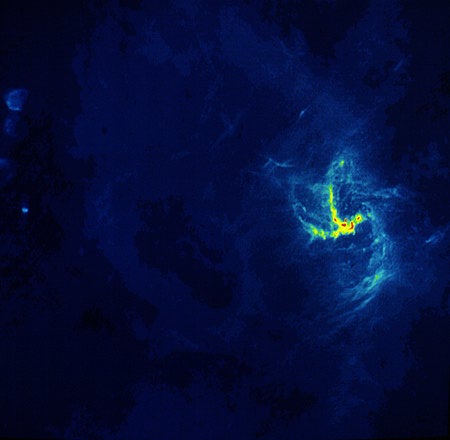 |
Here is a radio image of the central 5 x 5 parsecs of the Milky Way. Sgr A* is near the center of the bright, complex source to the right. Because of its appearance, this structure is called the "minispiral." Sgr A* is not clearly visible on this image, which emphasizes much larger structures. (from http://www.astro.utu.fi/~cflynn/galdyn/l13.html) |
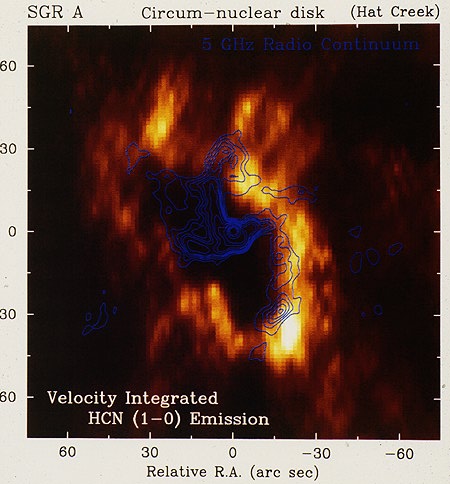 |
Here is an image in the emission of the HCN molecule, shown in yellow and orange. We see a ring of molecular material (diameter about 2 parsecs) surrounding the black hole. It is shown here imaged in a radio molecular emission line, but it shows up in other ways too. The minispiral is superimposed in blue contours. It appears to be filaments of gas falling inward from the molecular ring. |
The center of the molecular ring is filled with young stars. Why did these stars form, rather than the material falling into the black hole and making it a bright source? We do not know the answer for sure.
 Mixtec personification of
the Milky Way, from http://garnet.acns.fsu.edu/~dco2511/ Mixtec personification of
the Milky Way, from http://garnet.acns.fsu.edu/~dco2511/ |

Marvel Quasar Comic, http://www.coincidental.net/comics/series/quasar/1-033.html |
|
Click to return to syllabus |
||
| Click to return to the Type of the Milky Way | hypertext |
Click to go to the Active Galactic Nuclei |